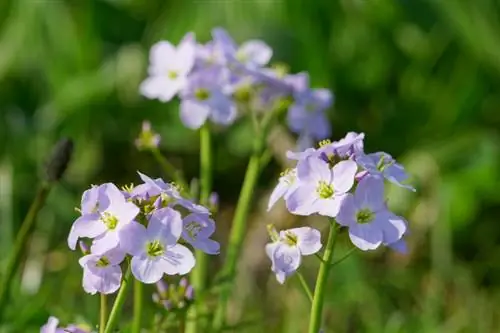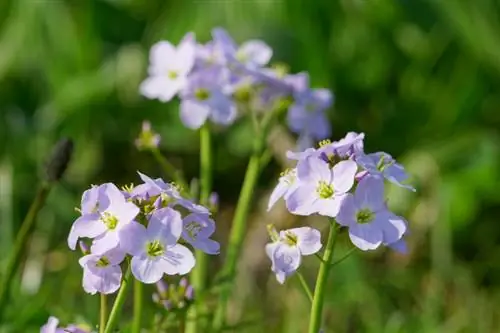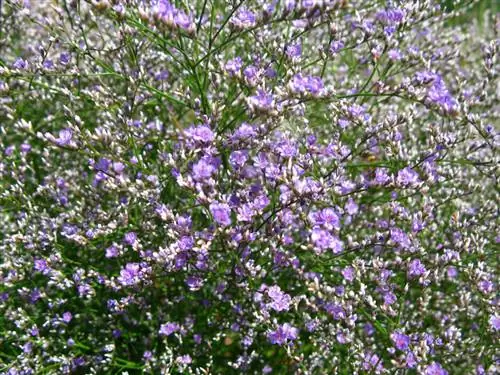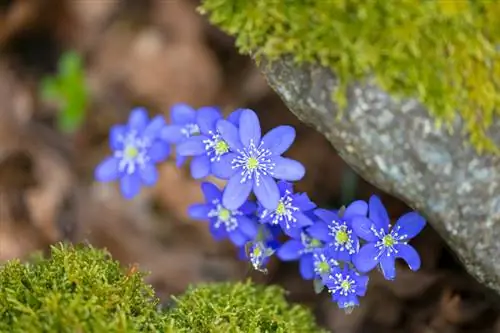- Author admin [email protected].
- Public 2024-01-10 23:11.
- Last modified 2025-01-23 11:22.
The enchanting meadowfoam transforms wet meadows, flowerbeds and pond banks into a picturesque sea of flowers. Flowers and leaves add culinary flair to a fresh spring salad. Don't wonder any longer how your native wild perennial thrives. The following answers to frequently asked questions get to the heart of the matter.

What is special about meadowfoam?
The meadowfoam is a native wild perennial that enchants with white, pink or light purple flowers from April to June. It prefers moist, nutrient-rich soil and grows in sunny to partially shaded locations. In the kitchen, the vitamin-rich flowers and leaves enrich salads and herb quark as an aromatic ingredient.
Planting meadowfoam correctly
You can plant a wild perennial grown in a container in the ground throughout the entire growing season. The meadowfoam finds ideal conditions when the planting period extends over the mild autumn months. Thoroughly loosen the humus-moist soil in a sunny to partially shaded location. Dig small pits at a distance of 20-30 cm that are half the volume of the root ball. Ideally, you put the excavated material into a wheelbarrow (€59.00 on Amazon) to mix in compost, horn shavings, bark humus or leaf mold. Before you pot up the young meadowfoam, soak the root ball with water until no more air bubbles appear. Placed in the middle of the planting hole, fill the cavities with the enriched substrate up to just the bottom pair of leaves and water. A mulch layer of leaves, grass clippings or bark mulch improves the rooting process.
Care tips
In order to enjoy the dreamy flower aspect, you need this manageable care program:
- Keep the soil constantly slightly moist
- An organic starter fertilization in March with compost and horn shavings
- Pruning back the withered flower stems down to the leaf rosette
- Cut close to the ground in autumn or late winter
We only recommend light winter protection in the year of planting. It is sufficient to cover the wild perennial with leaves and brushwood before the first frost. If the flower thrives in the pot, wrap the container in foil and place it on wood. Water occasionally during the winter to prevent the root ball from drying out.
Which location is suitable?
The meadowfoam spreads its natural charm in sunny to partially shaded locations with moist soil. The soil should be structured, rich in nutrients, humus and loamy. The distinctive wild perennial is therefore ideal for greening ponds, streams and small water worlds. A dreamy look is created when the perennial is integrated into the planting of a colorful wildflower meadow.read more
The correct planting distance
Since a single meadowfoam herb does not produce a carpet of flowers, an arrangement in small or large groups makes sense. Place the planting pits at a distance of 20-30 cm. For extensive greenery, we recommend arranging 10-12 plants per square meter.
What soil does the plant need?
The native meadowfoam feels most comfortable in fresh, moist soil. A nutrient-rich, humus-rich and clay-containing structure meets the modest wishes of the wild perennial excellently. A neutral pH value of around 7 is advantageous, although this is not a mandatory criterion.
When is flowering time?
From April to June, the meadowfoam delights us with racemose inflorescences, densely covered with four-petalled individual flowers. The dominant colors are white, pink and a light purple. Numerous insects, such as the unique aurora butterfly, are attracted by this floral display. The flower stalks are covered with alternate pinnate leaves and rise above a basal rosette of leaves.read more
Cut meadowfoam correctly
It is up to you to decide whether and when to cut a meadowfoam herb. We have put together all possible occasions for you here:
- Cut off wilted flower stems as soon as possible if self-sowing is not desired
- In autumn, cut the perennial close to the ground to enable independent propagation
- Cut all parts of the plant in late winter to use the fallen leaves as natural winter protection
- Cut the flower stems as vase decorations just before the buds open
- Cut the leaves in time before flowering to use them as herbs
As part of a flower meadow, special cutting measures are unnecessary, as these take place as part of the early summer and autumn mowing anyway.
Watering meadowfoam
If the meadowfoam is under drought stress, you will look in vain for the spring sea of flowers. Therefore, water the perennial regularly when the soil surface is dry and there is no rain. The watering can is used more often in pot cultivation because the substrate dries out more quickly due to the exposed location. Apply the water immediately to the root disc. Overhead irrigation impairs the beauty of flowers and unnecessarily provides opportunities for fungal infections.
Fertilize meadowfoam properly
In the appropriate location, the meadowfoam provides itself with the necessary nutrients. The wild perennial still happily accepts initial fertilization with compost in spring. Apply a liquid fertilizer to the pot and balcony box every 3-4 weeks from March to August, unless the flower was planted in pre-fertilized substrate shortly beforehand. In this case, nutrient supply begins 6-8 weeks after planting.
Diseases
Lovingly cared for, the historic wild perennial has a robust constitution and fends off diseases independently. In warm, humid weather, the meadowfoam is not immune to the ubiquitous fungal infection mildew. If a floury-white coating spreads on and under the leaves, a tried-and-tested home remedy can help. Mix lime-free water and fresh milk (not long-life milk) in a ratio of 9:1. Filled into a spray bottle, apply the solution to the tops and bottoms of the leaves every 2-3 days. Beforehand, cut off all already infected parts of the plant and dispose of them in the household waste.
Pests
The meadowfoam owes its name to its most important pest. These are black, brownish, straw-colored or spotted butterflies with a length of 5-8 mm. The larvae of the foam leafhopper frolic in small piles of foam on the perennial. This foamy covering protects the brood while they suck the sap from the stems. Since this process does not cause any significant damage to the flower, we recommend refraining from any control measures. In fact, the foam leafhopper is considered an essential factor in the ecological structure in nature. As a first-order consumer within herbivores, the insect serves as food for a variety of animals.
Wintering
The meadowfoam can cope with bitter frost down to -28.8 degrees Celsius without any damage. This feat of strength is successful because the above-ground parts of the plant are pulled in in the fall. Only the root ball survives the winter in the protective soil. There are therefore no special precautions to be taken. For a freshly planted perennial, we still recommend a layer of leaves as winter protection, as the frost hardiness has not yet fully developed.
Propagate meadowfoam
Two methods of propagation have proven themselves excellent in hobby gardens. The root ball is divided in spring or autumn. To do this, dig up the perennial, divide the root ball and 2 or more segments. In the new location, plant the sections as deeply as before and then water regularly and abundantly.
Collect the ripe pods with the seeds in July/August to dry them in an airy place. Stored in a dark screw-top jar, the seeds stay fresh until February. Sow the seeds thinly on a lean substrate. The light germinators are not sieved over, but are lightly pressed and moistened with a fine spray. Germination progresses quickly in a partially shaded, warm window seat. The strongest seedlings are transplanted into individual pots if they have 2 pairs of leaves. The linchpin of a successful course is the continuous water supply.
How do I transplant correctly?
The meadowfoam won't begrudge you a change of location. If the perennial languishes in a location that is too dark and in soil that is too dry, transplanting it will have a revitalizing effect on growth and abundance of flowers. This is also an excellent opportunity to rejuvenate an aging plant. This is how you proceed professionally:
- In spring or autumn, loosen the root ball with the digging fork
- Lift it out of the ground with a spade and place it on a solid surface
- Cut off bare spots, stunted roots with a knife
In a sunny location, make a pit in moist, nutritious and humus-rich soil. Mix the excavated material with compost and horn shavings. Place the meadowfoam precisely as deeply into the soil as in the previous location. Water the day itself and regularly afterwards to support rooting.
Meadowfoam in a pot
As long as an adequate water supply is ensured, there is nothing wrong with cultivating meadowfoam in pots. Commercially available compost-based potting soil can be used as a substrate. Although the wild perennial requires fresh, moist conditions, it should not become waterlogged. Therefore, insert a few pieces of pottery between the floor opening and the substrate as drainage. Water regularly as soon as the surface of the potting soil has dried. Freshly planted in pre-fertilized soil, start adding additional nutrients after 6 weeks at the earliest. Until August, apply a liquid fertilizer for flowering plants every 3-4 weeks. Cut off spent flower stems as soon as possible. The wildflower ideally spends the winter in a bright, frost-free area. If there is not enough space, wrap the pot with foil and place it on wood.
Is meadowfoam poisonous?
Meadowfoam is not poisonous. On the contrary, flowers and leaves enrich he althy cuisine as vitamin-rich ingredients. The slightly spicy leaves give curd cheese, herb quark, soups and salads an aromatic pep. Prepared as a tea, the leaves of the wild perennial alleviate he alth problems such as rheumatism, colds and mild headaches. However, only enjoy the plant in moderation, as the bitter substances it contains can cause slight stomach irritation.read more
Is meadowfoam edible?
The young, tender leaves can be harvested and consumed before flowering. Rich in vitamin C, they round off your spring salad, herb quark or cream cheese as a he althy ingredient. Thanks to the mustard oil glycoside it contains, meadowfoam tastes slightly spicy, similar to cress. The leaves have also made a name for themselves as a tea preparation in folk medicine to naturally relieve rheumatism, kidney disease and pain. Avoid consuming large quantities as the bitter substances they contain can irritate the stomach.read more






